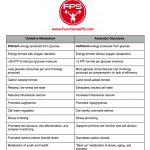Also see:
Promoters of Efficient v. Inefficient Metabolism
Comparison: Carbon Dioxide v. Lactic Acid
Universal Principle of Cellular Energy
Carbon Dioxide Basics
Carbon Dioxide as an Antioxidant
Protect the Mitochondria
Cellular Energy Production – Aerobic Respiration – The Krebs Cycle
The Glucose Song
Lactate: a metabolic key player in cancer
“Glycolysis is very inefficient for producing usable energy compared to the respiratory metabolism of the mitochondria, and when lactate is carried to the liver, its conversion to glucose adds to the energy drain on the organism.” -Ray Peat, PhD
“A point made by O. Warburg and A. Szent-Gyorgyi and others is that there is an important difference between the energy provided by glycolysis and that provided by mithocondrial respiration. They felt that glycolysis was a more primitive form of energy production, and supported only primitive function and cell division, while the more efficient respiration supported cell diferentiation and complex functioning.” -Ray Peat, PhD
“The end product of respiration is carbon dioxide, and it is an essential component of the life process. The ability to produce and retain enough carbon dioxide is as important for longevity as the ability to conserve enough heat to allow chemical reactions to occur as needed.” -Ray Peat, PhD
“If the oxidative metabolism of a cell is compared to a flame, lactic acid is the smoke that’s produced when there isn’t enough oxygen, or when the temperature is too low. Both a cell and a flame produce produce carbon dioxide when nothing interferes with their oxidation.” -Ray Peat, PhD
“Sugar can be used to produce energy with or without oxygen, but oxidative metabolism is about 15 times more efficient than the non-oxidative “glycolytic” or fermentive metabolism; higher organisms depend on this high efficiency oxidation for maintaining integration and normal functioning: If there is a small interference with respiration, the organism can adapt by increasing the rate of glycolysis, but there must be enough sugar to meet the demand. A response to stimulation is the production of more energy, with a proportional increase of oxygen and sugar consumption by the stimulated tissue; this produces more carbon dioxide. which enlarges the blood vessels in the area, providing more sugar and oxygen. If the irritation becomes destructive, efficiency is lost: oxygen is either consumed wastefully, causing blueness of the tissue (assuming circulation continues: blueness can also indicate bad circulation), or is not consumed. causing redness of the tissue. As more sugar is consumed in compensation , lactic acid also enlarges the blood vessels.
If the inflamed or exhausted tissue is small, the lactic acid can be consumed by other oxidizing tissues, sufficient sugar usually can be supplied, and repair occurs. But a large inflammation. or profound exhaustion, will lower the blood sugar systemically, and will deliver large amounts of lactic acid to the liver. The liver synthesizes glucose from the lactic acid, but at the expense of about 6 times more energy than is obtained from the inefficient metabolism – so that organismically, that tissue becomes 90 times less efficient than its original state. Besides this, an idle destruction of energy molecules (ATP or creatine phosphate) will increase the wastefulness even more.” -Ray Peat, PhD
“The conversion of glucose to lactic acid, provides some usable energy, but many times less than oxidation provides.” -Ray Peat, PhD
“These factors that impair respiration tend to shift mitochondrial metabolism away from the oxidation of glucose and the production of carbon dioxide, to the oxidation of fats and the production of lactic acid.” -Ray Peat, PhD
“The balance between what a tissue needs and what it gets will govern the way that tissue functions, in both the short term and the long term. When a cell emits lactic acid and free radicals and the products of lipid peroxidation, it’s reasonable to assume that it isn’t getting everything that it needs, such as oxygen and glucose. With time, the cell will either die or adapt in some way to its deprived conditions.” -Ray Peat, PhD
“The presence of carbon dioxide is an indicator of proper mitochondrial respiratory functioning.” -Ray Peat, PhD
“For the advantage of being able to extract energy from glucose in the absence of oxygen, the anaerobic organism must waste over 90% of the total energy it might be able to obtain if it could oxidize glucose with molecular oxygen to CO2 and H20.
In the aerobic organism lactate does not leave the cell; instead it, or pyruvate, is oxidized to CO2 and H20, with the recovery of much of the other 93% of the energy of glucose. Respiration, the oxidation of glucose with molecular oxygen, is clearly very efficient in extracting all of the possible energy from the glucose molecule…
Because anaerobic glycolysis can extract only a small fraction of the total energy of the glucose molecule, it is corollary that anaerobic cells must use much more fuel per unit of time per unit of weight to accomplish the same amount of cellular work as an aerobic cell. It has been found that anaerobic cells use up to twenty times as much glucose as aerobic cells to do the same amount of work. And they can consume many times their weight of glucose in only short periods of time.” -Albert Lehninger, PhD
This chart is not intended to be an exhaustive comparison but rather a general overview.

